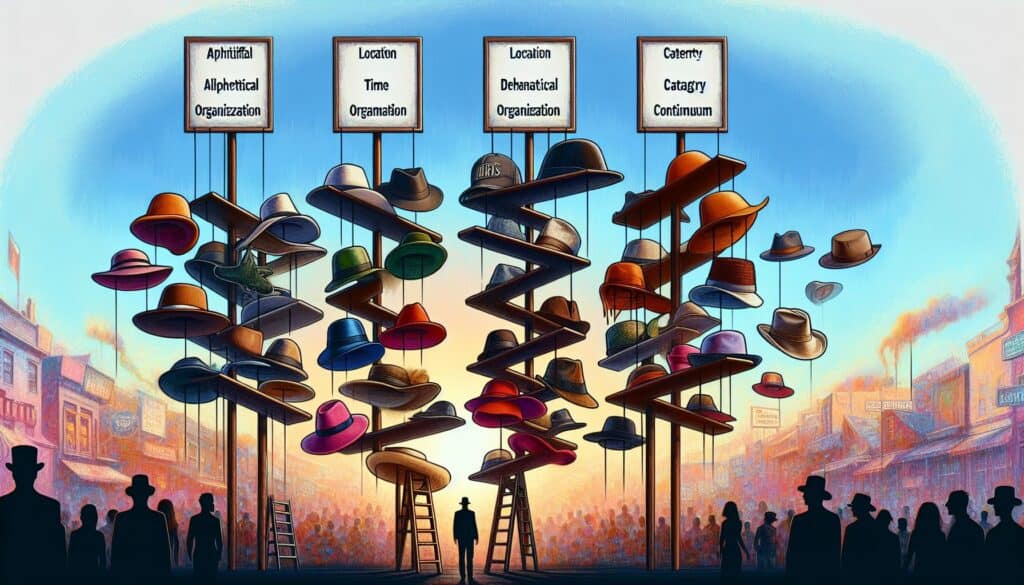Per fornire un struttura of five fundamental ways to organize information: Location, Alphabet, Time, Category, and Hierarchy (or Continuum).
- Metodologie: Clienti e marketing, Economia, Progettazione del prodotto
Cinque porta cappelli (LATCH)

Cinque porta cappelli (LATCH)
- Metodologia agile, Pensiero progettuale, Architettura dell'informazione, Miglioramento dei processi, Gestione del progetto, Usabilità, Test di usabilità, Esperienza utente (UX), Interfaccia utente (UI)
Obiettivo:
Come si usa:
- When designing information systems, interfaces, or content, information is structured using one or more of these organizational schemes to make it findable and understandable for users.
Professionisti
- Offers simple and intuitive ways to structure information, applicable to a wide variety of content and contexts, helps create logical and user-friendly information architectures.
Contro
- Can be too simplistic for highly complex information sets, choosing the most appropriate 'rack' can sometimes be ambiguous, may require a combination of methods for optimal organization.
Categorie:
- Clienti e marketing, Ergonomia, Progettazione del prodotto
Ideale per:
- Organizing information in websites, applications, documents, and physical spaces to improve usability, navigation, and comprehension.
Five Hat Racks (LATCH) is particularly beneficial in sectors like e-commerce, education, healthcare, and any field requiring effective information presentation. For instance, in e-commerce platforms, categorizing products based on location, alphabet, time, category, or hierarchy allows users to swiftly find items, enhancing their shopping experience and potentially increasing sales. In educational applications, organizing materials by audience, such as students or teachers, ensures relevant content is easily accessible. In healthcare, patient information systems can utilize LATCH frameworks to filter data efficiently, aiding healthcare professionals in rapid decision-making. This methodology can be initiated by designers, information architects, or project managers during the early phases of system or interface design, fostering collaboration across disciplines, including UX/UI design and content strategy, ensuring that all relevant stakeholders contribute to the structure of the information. In contexts like workshops or brainstorming sessions, participants can collectively assess the most appropriate organizing principles by visually mapping content and user needs. Utilizing LATCH not only provides an intuitive structure but also makes the architettura dell'informazione adaptable to various design processes, leading to better user satisfaction and engagement across diverse platforms and environments.
Fasi chiave di questa metodologia
- Identify the types of data or content you have.
- Choose the appropriate organizational scheme from the LATCH categories: Location, Alphabet, Time, Category, and Hierarchy.
- Map the content onto the chosen scheme, ensuring it aligns logically with user needs.
- Test the structure with potential users to gather feedback on usability and navigation.
- Refine the information architecture based on user feedback and observations.
- Implement the structured information into the design of the system or interface.
- Monitor user interaction to continually assess the effectiveness of the information organization.
Suggerimenti per i professionisti
- Utilize LATCH in a hierarchical manner, starting with the most relevant layer of information to establish a clear path for users.
- Combine multiple LATCH components for cross-referencing, enhancing depth without overwhelming users by maintaining clarity in primary navigation.
- Regularly test LATCH structures with real users in context, adjusting based on feedback to ensure that the organization meets evolving user needs.
Leggere e confrontare diverse metodologie, raccomandiamo il
> Ampio archivio di metodologie <
insieme ad altre 400 metodologie.
I vostri commenti su questa metodologia o ulteriori informazioni sono benvenuti su sezione commenti qui sotto ↓ , così come tutte le idee o i link relativi all'ingegneria.
Contesto storico
1960
1980
1983
1990
1995
2000
2010
1950
1980
1980
1986
1994
1995
2000
(se la data non è nota o non è rilevante, ad esempio "meccanica dei fluidi", viene fornita una stima approssimativa della sua notevole comparsa)














Post correlati
Questionari sul disagio muscoloscheletrico
Test multivariati (MVT)
Analisi di regressione multipla
Sistemi di cattura del movimento
Metodo MoSCoW
Test mediano dell'umore